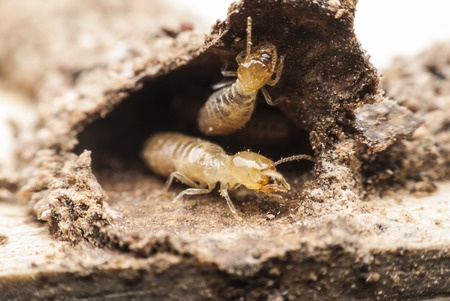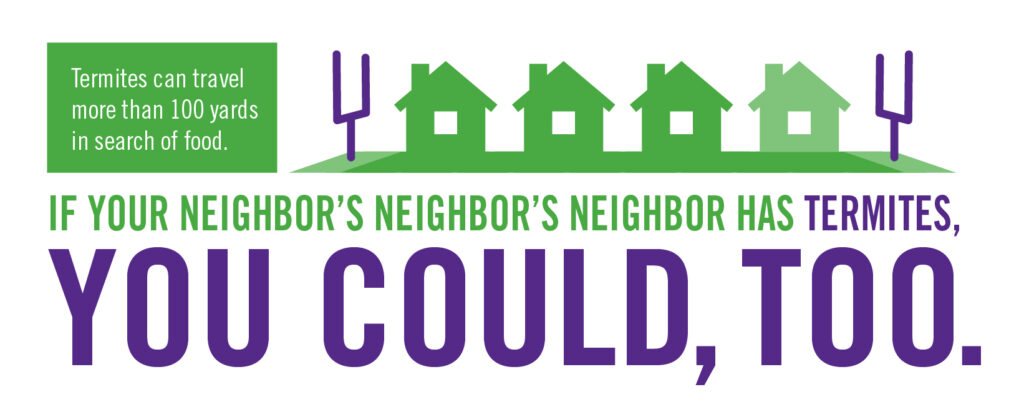April is here, and that means so are the termites. Are you prepared for the insect activity that comes with the month of April? In Georgia, termites are active year round but typically swarm throughout the spring. Why is this important for homeowners? Termite infestations can cause extreme damage to buildings and furniture. Continue reading from out Termite guide to keep your home safe.
Termites pose a threat to your biggest investment: your home.
Did you know.. Termites cause more than $5 billion worth of damages annually in the United States, according to the National Pest Management Association. That’s more than fires, earthquakes, and storms combined!

Unfortunately, most homeowner insurance policies do not cover termite damage. In addition, most termite infestations are well established before outward signs become visible, but becoming familiar with termite infestation signs may help you identify an infestation and get prompt treatment.
To prevent or treat a termite infestation properly, it’s important for homeowners to be able to properly identify termites. Follow our Homeowner’s Guide to Termites to determine what termites look like, the difference between termites and ants, how to spot a termite infestation, and more.
Affordable Plans For
Pest Control
Get your complimentary quote by phone and be one-step closer to pest-free living. We will create a service plan that best fits your needs and a state-certified pest control professional will perform thorough service.
What Do Termites Look Like?
Termites have a thick waist, straight antennae, and, if they have wings, their wing pairs are equivalent sizes.
Oftentimes, termites resemble the appearance of flying ants and the identification between these two insects can easily get confused. The difference between termites and ants is extremely important because this determines which type of pest control service you need for your property.
There’s three distinct ways to determine the difference between termites and ants:
Termites |
Ants | |
| 1. Body Segment | Thick, straight waist | Distinct, pinched waist |
| 2. Antennae | Straight | Bent |
| 3. Wings | Pairs same size | Front wings longer than back wings |
Why is Spotting Termites So Difficult?
Owning a true secretive nature, spotting termites or a termite infestation can be difficult to detect. Additionally, you will likely notice termite damage before spotting the termites yourself. Homeowners are often fooled because termites look so similar to ants.
Body Segment: Termites have thick/ straight waists, while ants have distinct/ pinched waists.
Antennae: Termites have straight antennae, and ants have bent antennae.
Wings: When termites have wings, both of the pairs are the same length. When ants have wings, the front wings are longer than the back wings.
If you have an ant infestation, please visit our Ant Control Guide.
Now that we have identified the difference between termites and ants, let’s discuss the different types of termites. It’s important to be able to identity which type of termite is posing a threat to your home. However, it’s even more important to understand the issue is termites vs. your home.
What are the Different Types of Termites?
- Subterranean Termites
- Drywood Termites
If you have termites in/around your home, it’s important to understand which type of termites you are dealing with to determine which type of termite treatment you need. Subterranean termites treatment differs from drywood termite treatment.
Subterranean Termites
This is the most common type of termite in the US. Subterranean termites’ nests are underground. These termites have large colonies, do not kick out debris, and eat along the grain of the wood. Subterranean termites develop in the colony, and they leave their nests underground to start new colonies.
Drywood Termites
Drywood termites do not require soil contact. Instead, they nest inside the wood they are infesting. These termites leave small piles of debris outside the infested wood.
Do Termites Fly?
Yes. Termites that fly are called “swarmers”. Flight is an important component of a termite’s reproductive process. In addition, termite swarms are most active during the spring, which gives power to the saying ‘warming means swarming’.
However, the adult reproductive termites, called swarmers, do not fly very well. Swarmers shed their wings shortly after they settle on the ground.
Do Termites Bite? Can Termites Harm Humans?
Termite populations are notoriously known for causing damage and harm to homes, but not to people. Soldier termites do have the ability to bite humans, but they would only bite if handled. Termites are not known to carry diseases harmful to humans. Homeowners experiencing a termite infestation should not be concerned about bites from termites. Instead, termites bite wood and attack other insects.
When Do Termites Swarm in Georgia?
In Georgia, termite swarms typically occur in the springtime.
As the weather warms up, termites start new colonies. First, they send out “reproductive” termites, who will later be the “kings” and “queens” of their future colonies. These reproductive termites leave the nest at the same time looking for a mate. This is called a “swarm” when a large amount of termites are searching for mates. Termites swarm in Georgia from March to May.
The rain and warm temperature facilitates this process. The winged termites emerge from soil, cracks, or holes looking for a mate, new nest sites, and food sources.
How Can I Defend Against A Swarm?
The best defense against a termite swarm is a properly maintained home, which includes proper storage, ventilation, and drainage. Additionally, it’s important to have a professional pest control service inspect your home for termites annually.
What are Signs of a Termite Infestation?
- Termite mounds
- Hollow-sounding wood
- Red clay or mud trails
- Sagging of floors or ceilings
- Mud tubes on exterior walls
- Crumbling wood of any structure type
- Cracked or distorted paint on wood surfaces
- Groups of winged insects (“swarmers”) or discarded wings
How to Deal with a Termite Infestation
Termites pose a serious threat to your biggest investment: your home. Termites could be silently feasting on your home’s structure. If you suspect that you have termites or if you have an inside swarm, it is best to let a professional pest control service handle the termite treatment.
Here at Lookout Pest Control, formerly Any Pest Inc., we offer Sentricon Termite Baiting systems, as well as Liquid Barrier treatments to detect and eliminate termites in and around your home. Our termite baiting systems are installed in the soil around your home or office and will be monitored annually for termites. If termites were to be present, when they feed on the termite bait and bringing the Active Termite Bait back to their colony. As the termites continue to feed on the active bait, and more and more termites are affected, the termites will die and the termite colony is eventually eliminated.
Free Termite Inspection Near Me
If you ever notice any of the above termite warning signs and believe you may have termites in your home, don’t wait until it’s too late. Contact us today for a free termite inspection and to receive more information about our termite protection plans.
Prevention is always the best treatment. Don’t wait until a swarm happens in/around your home. Call Lookout Pest Control today for a free termite inspection at (678) 888-0035!
Warming Means Swarming: The Homeowner’s Guide to Termites in Kennesaw, GA and beyond!
Proudly serving Cobb County and the Atlanta Metro Area. Any bug, Lookout Pest Control.
